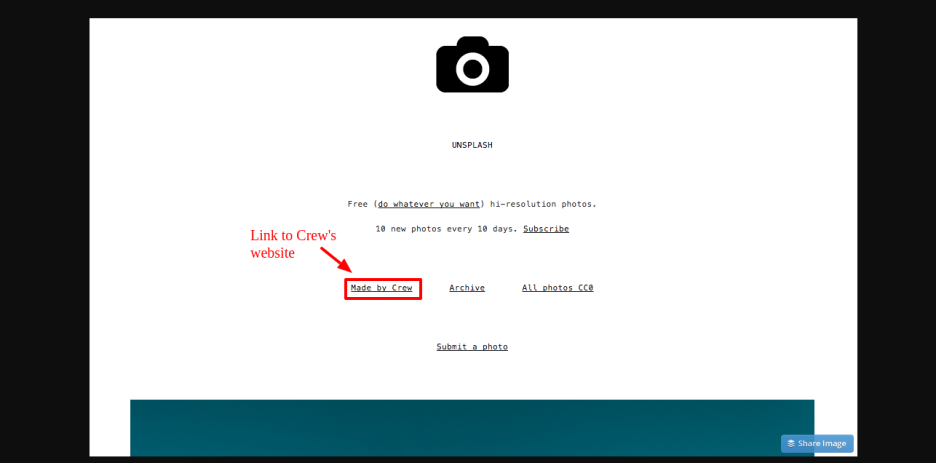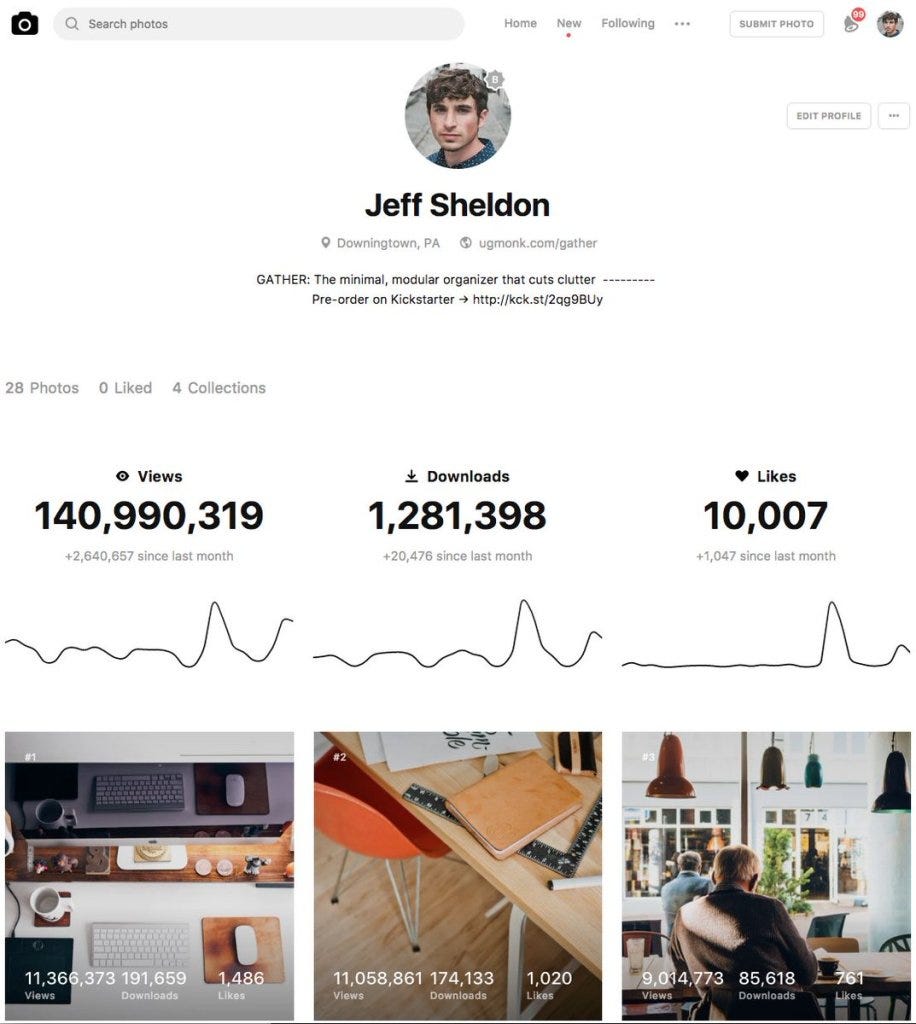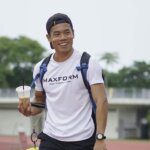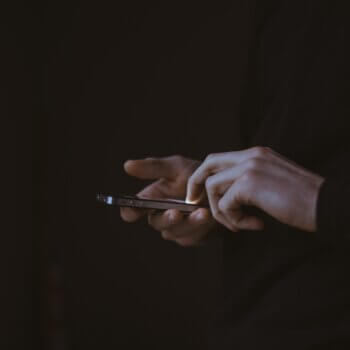How could you go from almost no traction and running out of money, to getting millions of visitors to your website?
You could do like Crew accidentally did with Unsplash. Create an open source side project that directs millions of visitors to your paid product.
At the beginning, when they were starting a marketplace for freelancers, Crew couldn’t find a good photo for the homepage of their website. So they hired a photographer (what they found online was either too crappy, or too expensive).
Once they did the photo shoot, they had a ton of leftovers. So they chose 10 pictures and put them up on a Tumblr blog for others to download for free — “10 free photos every 10 days”.
And from the moment Unsplash/Crew promoted their 10 pictures on a humble Tumblr blog on HackerNews, they’ve been getting millions of visitors and redirecting thousands of new customers to Crew’s marketplace, ultimately saving their business.
[With Unsplash] We kept having this huge growth curve for the amount of effort that we were putting in, while on Crew, we had a full team and we were trying to get growth and it was a real battle. Eventually, we hit a million downloads within that first year, and that was our mark that this was really not slowing down – Mikael Cho, Founder of Crew and Unsplash
That’s just an incredible return on investment for a few unused pictures that were going to gather dust in a hard drive.
That’s why today I’m going to show you some of the tactics Unsplash used to grow and sell Crew, their freelance marketplace, and grow their photography platform to 1 billion photos viewed per month with over 300,000 free high-resolution photos and 50,000+ contributors.
1. Take your “unused” creations to untap unreachable distribution channels
Unsplash had unused photos from a photo shoot for their website. And they had three choices. They could forget about them. They could try to sell them on a stock photo website. Or they could just give them away.
And giving them away has proven to be a far better idea than just keeping them for themselves or trying to sell them on a stock photo platform.
Recently, a team of researchers found that the most shared articles from the New York Times were ones that gave readers practical utility. Giving someone something useful tends to have the biggest impact on people. When you pair two powerful things like giving and photography, you reach a whole new level of impact.
To start doing this, you can use simple and free tools like WordPress.
Unsplash started on a $19 Tumblr blog to post its free photos. Once it really got traction and attracted customers and cash, it made sense to spend some time and money on building a proper platform to host Unsplash.
We believed the good from giving our images away would far outweigh what we could earn if we required payment or credit. This proved true. By setting our images free, Unsplash turned into something much more meaningful than the hundreds of dollars we likely would have made selling them. Those first 10 photos photos have been seen 58 million times. Unsplash has become a community of over 20 million creators. People from all over the world have generously contributed over 250,000 photos, moving hundreds of millions of creative acts forward – Mikael Cho.
Unsplash photos have not only helped designers and entrepreneurs create demos and websites, but have been a source of inspiration for everyone from teachers to nonprofits to independent creators.

If you are a designer or content creator — whether it’s code, recipes, agriculture, film editing, graphic design, photography, fashion, electronic hardware, material design, cars, planes, robots, or whatever — and it’s hard to get distribution for your work, there is a place for your open sourced ideas, especially if you share quality content and design.
Unsplash, Github, Instructables, Arduino, Adafruit, OS Vehicle (Now Open Motors), Local Motors, Wikihouse or Opendesk’s successes are a testament to that.
When two-time #1 New York Times best-selling author Tim Ferriss was blocked from distributing his book in Barnes & Noble, he uploaded excerpts from his book for free on BitTorrent to get distribution. Writer Leo Babauta “Uncopyrighted” everything on his popular blog, Zen Habits, in service of spreading his work further than he ever could alone. Chance the Rapper became the first artist to win a Grammy without selling physical copies of his album and giving most of his music away for free – Mikael Cho
You share something for free and attract an audience and contributors, which in turns attracts an even bigger audience and inspires even more contributors to create and contribute.
70% of people who download images from Unsplash are people who have never downloaded anything from a stock photo site before. And the same applies to any other industry. 70% of people who will download new copyright-free content will be people who are currently not buying anything from that industry anyway, but who could in turn become creators, remixers, and promoters.
It’s fair to imagine that if you share your designs in open source and invite other to share as well, you could be untapping a whole new audience who would have never have had access to your kind of work and help you build and promote it.
Takeaways:
- Make a list of all of the unused content you have created
- Share this content in open source on a WordPress, Dropbox or whatever free tool you can find. Make sure of three things. Firstly, the content you’re sharing should not be widely available elsewhere. Secondly, people should find the content really useful even though it’s free and be motivated to contribute to its creation. Thirdly, the content should be so useful that people would be ready to pay for it.
- Open and publish 1 to 10 ideas per month. For example, 1 to 10 photos or designs per month.
- And offer people to subscribe to your newsletter to get more open ideas each month so that you can keep growing your audience.
2. Find an audience who would pay for your open source project, and give it away freely
Don’t go to where your open source audience is. Instead, go to where people are already paying for the kind of open source content you are already sharing.
A mistake I see many people make, and that I also made myself in the beginning, is to share your work with other peers because they will understand what you’re making. Many developers join other developer events or LinkedIn Groups, instead of going to events or groups where nobody does what they do.
Beware, your peers know how to do what you do, so they might be interested in your open source content, but they won’t pay you for whatever other service you offer.
So you should look for people who will pay for your services. And if you are a non-profit, this would be people ready to push the donate button.
Nothing beats free. So whatever people have been paying for, they’ll be delighted to get it for free. Which should drive tons of traffic and attention to your open source project, but also to your paying products.
In Unsplash’s case, they didn’t go to photographers at first. They went to Hacker News to share their free photos, a website that gathers a community of entrepreneurs and computer science enthusiasts.

We put that up on Hackernews, and within a few hours, it went to number one. The site started crashing because we had public Dropbox links. The head of engineering at Dropbox happened to look at the Hackernews post and said that they’d upgrade us to the maximum pro plan for the day. They’re not supposed to be used for public Dropbox links, but he said they’d keep the site up because they think it’s cool. And that was day one of Unsplash – Mikael Cho
Cho knew his audience was looking for free and beautiful photographs for their websites. And they are often hard to find even on Flickr, or even in stock photography websites. So Unsplash was a really good fit.
And on top of that, an audience of entrepreneurs could also be interested in hiring other developers, freelancers and designers on their Crew website, creating a virtuous circle for their business.
Here are some other examples of open source projects’ paying audience and peers:

Takeaways:
- Make a list of the kind of people who already pay for the content you’re offering in open source
- Then list the websites or events where these people go to regularly
- Promote your open source content in these websites and events. For example, Unsplash went to Hacker News, VentureBeat, Digital Trends, Lifehacker, and Tech Vibes, where it knew many developers are looking for free and beautiful photographs people couldn’t find on Flickr.
3. Direct traffic to your service or product page with your open source project
Once Unsplash got people coming to their platform, they just had to add a link to Crew to attract new clients to hire freelancers from their marketplace.

This simple link in Unsplash has attracted over 5 million visitors to Crew. From mobile and web designers and developers willing to offer their services on Crew, to paying customers interested in hiring their freelancers to get custom websites or apps made.
But Unsplash doesn’t only benefit Crew. Any photographer contributing images can add a link to his own business and benefit from Unsplash’s traffic.

In Fact, by uploading 460 images, Samuel Zeller has gotten over 255 million views and over 1.7 million downloads of his images.
That’s how his first client, the biggest banks in Switzerland, found him and gave him 4 projects when he started as a freelancer in 2016.
The reason why they reached out to him? They were already using a few of his Unsplash images in their global database and wanted more in the same style.
Takeaways:
- Use your open source project to link to and promote a paying service. For example, Unsplash used to link to Crew’s Marketplace. Adafruits tutorials links to their e-commerce products, WordPress links to their affiliate hosting partners, and so on.
- Give contributors a place where they can promote their own profiles and services.
4. Create a win-win relationship with your creators of free content
Once you’ve found people willing to pay for your services and download your open source content, it’s time to invite your peers to contribute.
This will make your open content more valuable, and will also attract an audience your contributors want to reach.
At the beginning, photographers could post ten photos every ten days on Unsplash if they had been approved. And that’s really when Unsplash took off to another level.
Unsplash could compel photographers to give their pictures for free by showing them that giving content sitting in their hard-drives could help them create an audience for themselves.
Some other benefits they could get for contributing are:
- To direct unprecedented amounts of exposure that created a lot of site traffic
- To get client referrals
- To use it as social proof (a photographer can tell his clients that his pictures have had thousands of views and downloads on Unsplash)
- To practice their craft
- To use photos to build an audience they can direct toward making a living.
- Or trying to truly give back to the community.
In fact, photographers have themselves reported getting client work booked after posting just a couple of photos. Others have been flown around the world on photoshoots. Some have gotten enough work to leave their jobs and become full-time photographers. Some have been able to build audiences for new products. And every contributor Unsplash spoke to has enjoyed the impact their photography has made toward moving creativity forward.
Today, a photo featured on Unsplash is seen more than a photo on any other platform. More than on Instagram. More than on the front page of the New York Times.

Photographers no longer need to come with an audience or have an agent to be great. Unsplash brings an audience to them.
As an independent designer myself, I understand you can’t do everything for exposure because exposure doesn’t pay the bills. But to completely dismiss the value of exposure doesn’t make sense either.
All artists need an audience to survive. Why do we spend time posting on Instagram if we don’t get paid for it? Because those posts build an audience over time.
In the last ten years, several platforms like YouTube, iPhone, Twitter, Instagram, SoundCloud, and Medium have enabled more and more of us to express and connect. Sometimes, this expression and connection is done for fun. For nothing but the purpose of creating. Other times it’s done to create an audience for something else. Filmmakers distribute trailers for free on YouTube to sell a movie. Musicians release free songs or entire albums on SoundCloud to sell concert tickets. Authors give free chapters and pour thousands of unpaid hours into blogs to sell a book.
New open source platforms don’t kill industries. They change the distribution – Mikael Cho
Open Source platforms can open up an opportunity for so many people to share their craft with huge audiences instantly. New platforms create a distribution channel and community we otherwise wouldn’t have. In this sense, there’s never been a better time to be a creator.
Takeaway:
- Make a list of places, websites and events where your peers are hanging out
- List and explain to contributors the benefits they’ll be getting by contributing their own content (For example, getting site traffic to build their audience, get client referrals, social proof, a way to practice their craft or give back to the community)
- Provide a way for others to contribute their own content as well and curate their content. This could be a simple call to action to send you a contribution by email at the beginning, and after a while you could just create a form from which people can directly post their submissions.
- Curate their contributions to make sure quality is high
- Encourage your community of contributors to use your project to promote their own paying services or websites so they can also benefit from sharing their content in open source. The bigger the incentive to contribute, the more they’ll want to build open source content on top of your platform.
5. Creating other revenue streams for Unsplash’s Future
Now that Crew has been sold to Dribbble, Unsplash became its own entity. Since it can’t rely on Crew to fund its operations anymore, it has to become financially sustainable.
So to find new ways to earn money with a 100% open source company, there are a few ways that Unsplash could be headed foward:
Native advertising:
There’s a lot of really interesting real estate that exists on Unsplash. For example, the way people are using Unsplash today is a lot like Google search except that it’s for images. The plan is to add a native advertising component to Unsplash.
Let’s say someone is searching for shoes and there are these really nice pictures of shoes already on the platform. Let’s say Nike shoes are also on the platform. That way you’d have a native advertising element that’s built into that search.
It’s would still be a high-quality thing. Instead of using crappy banner ads and showing a bunch of advertisements, targeted ads could be displayed. This would add value to Unsplash and would also be a way for Unsplash to make revenue.
Unsplash could also work with contributors to make some of the content, so the photographers who work with a brand and want to get involved with Unsplash could actually make connections.
There’s a whole double benefit that happens. We believe that the best way we can make money is to help others make money – Michael Cho
People searching for these images can in turn embed them in their websites, creating even more advertising for the brand.
Other Open Source projects like Read the Docs are funding their projects with what they call “ethical advertising”.
- They respect users while providing value to advertisers.
- They don’t store personal information about users.
- They only keep track of views and clicks.
- They don’t build a profile of your personality to sell ads against.
- They only show high quality ads from companies that are of interest to developers.
- The products advertised should be interesting to the user.
- The ads won’t flash or move.
- They report that they run the ads they want to have on their site, in a way that makes them feel good.
- And they also give 10% of their ad space to community projects, as a way of saying thanks to the open source community.
Update: Unsplash actually put in place their sponsored banners after this post was written. You can find them in the homepage and in the reminders to credit the photographers you get when you download an image.

Ad Revenue Sharing for Photo Contributors
Another way Unsplash could make money would be to insert these ethical or native ads and give the ability for contributors to opt into an ad revenue sharing option.
Scott Webb explores this idea:
Could Unsplash work out some kind of algorithm to determine ad revenue for contributors based on their photo views and photo download? Maybe photo likes would be incorporated into the algorithm too.
Whatever the case may be, with highly targeted native advertising built into the site, could a revenue share happen with contributors? Could we see something like we see for content creators on YouTube, but with photos?
I don’t know how it could be technically worked out, but that Unsplash Team is smart or they’ll find the talent to make it happen.
Takeaways:
- Find a simple business model to fund your open source operations.
- If you don’t know how or where to start, to find out how to make money with Open Source, go to this post from the great Lars Zimmermann. See which model suits your project best, and get creative.
Conclusion
Unsplash has become a key player in the digital photography industry. You can do something similar by being the one to disrupt an industry yourself. Gather your community and benefit your industry.
Here are the 5 key takeaways you can borrow, modify, and adopt for your own business based on Unplash’s real-life marketing tactics:
- Leverage unused content you have created. Share it on a free platform like WordPress or Dropbox and publish every month 1 to 10 new ideas or designs. Invite people to subscribe to your newsletter to keep growing your audience
- Find those people who are already paying for what you are offering for free.
- Once you know where they are, promote your open source content in the websites and events where they hang out. Don’t forget to put a link to your paying project in your open source content.
- Make it a no-brainer for people to contribute. Give contributors a page where they can promote their own profiles and services, list the benefits they get for contributing, and invite them to your project.
- Find a simple way to get paid for your open source operations. See which model suits your project best, and get creative.
About the Author
This article was written by Jaime Arredondo, Creator at Bold&open. He likes to help others make an impact with their collaborative ventures at www.boldandopen.com.





























